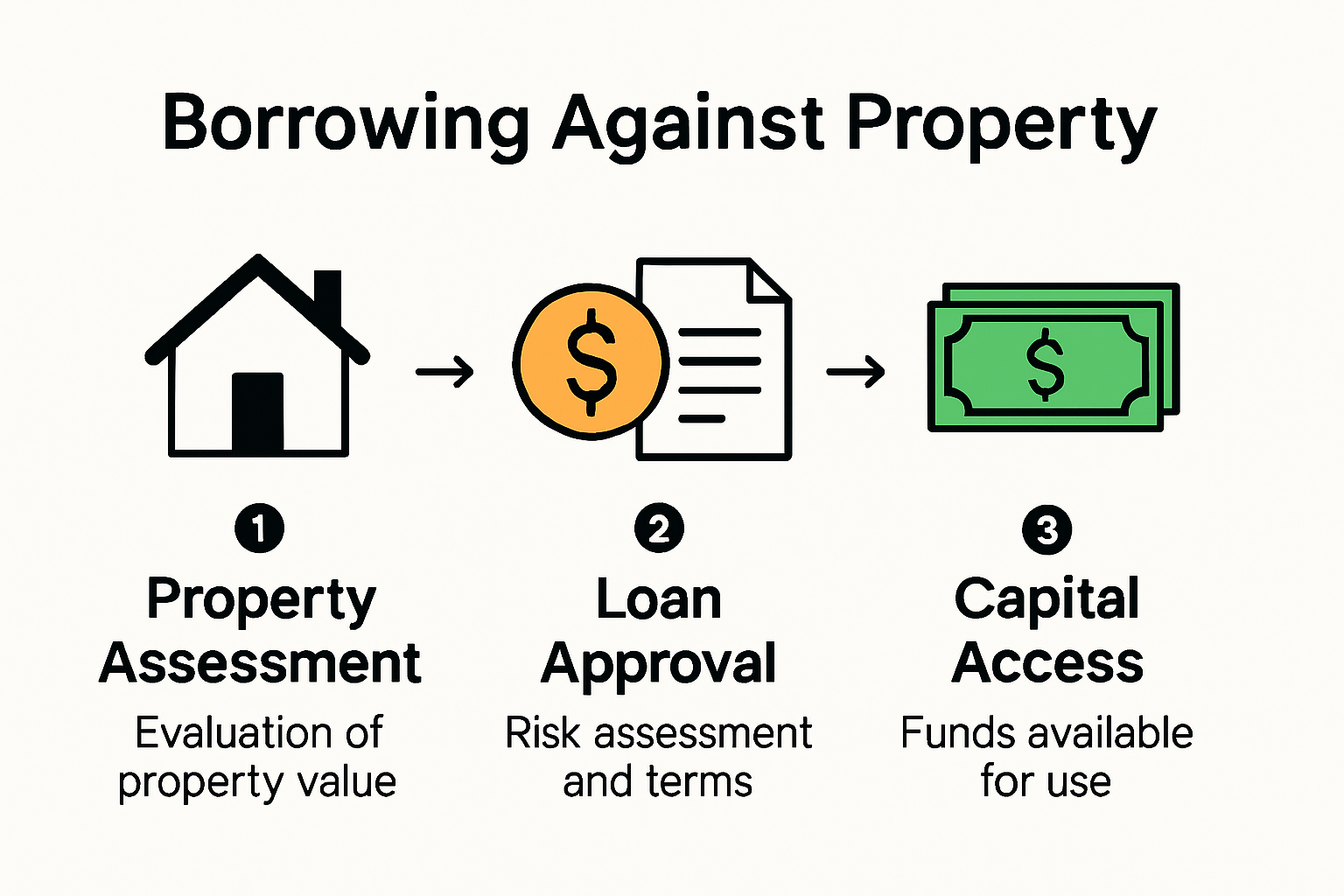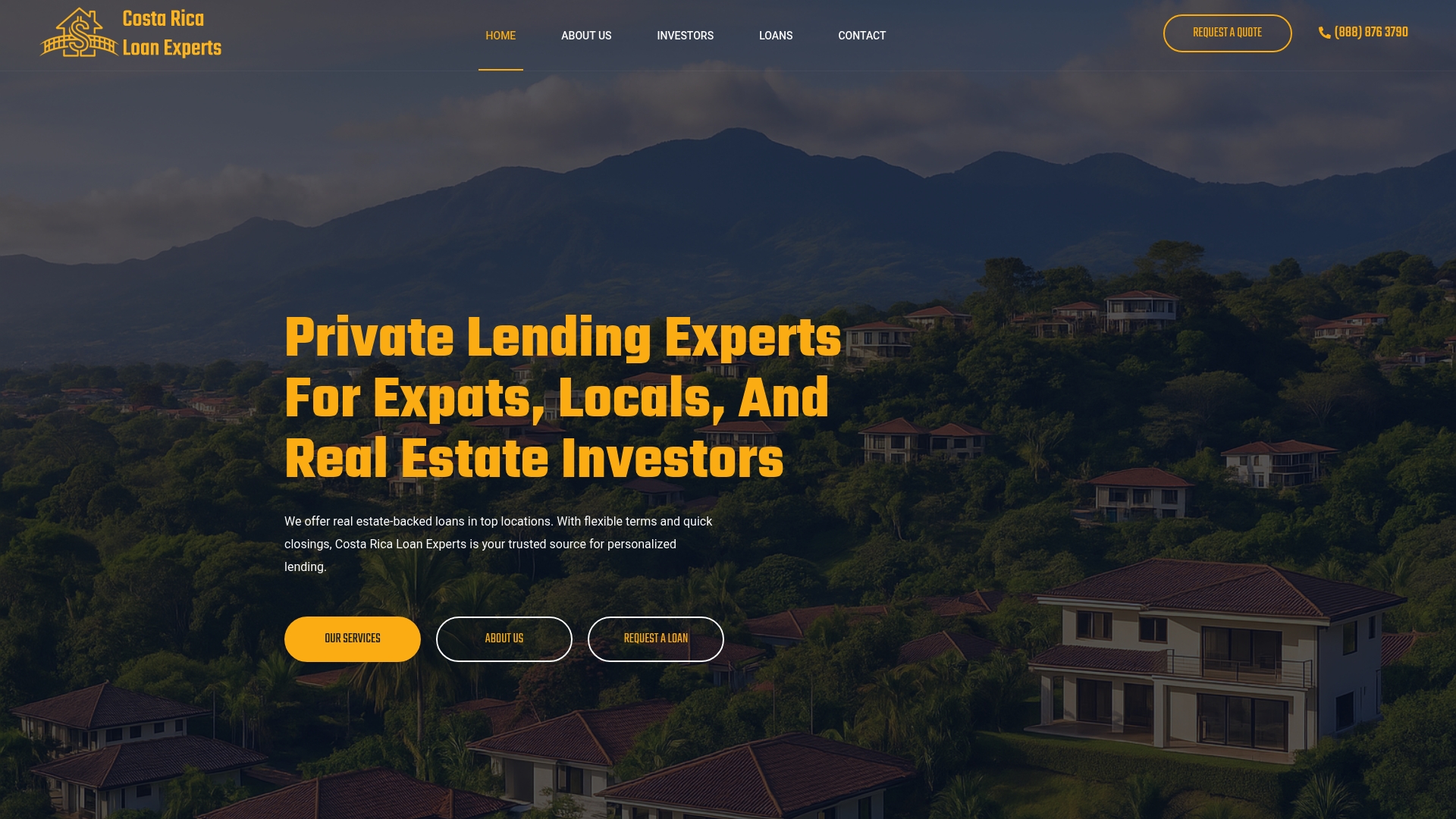
Borrowing against property is taking off in 2025, especially for investors and expats aiming to unlock serious capital. Did you know you can typically access between 50 and 80 percent of your property’s market value without having to sell it? Most people think this kind of financing is out of reach or too risky if you are not a local. The real surprise is that with the right strategy, even complex markets like Costa Rica are opening doors for international investors to tap into powerful lending tools many traditional banks still overlook.
Table of Contents
- How Borrowing Against Property Works
- Best Loan Options For Expats And Investors
- Risks, Benefits, And Key Considerations
- Tips For Success In Costa Rica Real Estate
Quick Summary
| Takeaway | Explanation |
|---|---|
| Leverage Real Estate Equity | Borrowers can access liquidity by using their property’s value as collateral, enabling funds for renovations, investments, or cash flow management without selling the asset. |
| Understand Loan Structures | Familiarize yourself with various loan types such as fixed-rate loans or lines of credit, which cater to different investment goals and offer flexible financing solutions. |
| Conduct Thorough Risk Assessment | Analyze market conditions, property values, and personal finances to mitigate risks associated with borrowing, such as potential foreclosure or income stability issues. |
| Prioritize Legal and Financial Foundations | Investors, especially expats, should ensure legal clarity on property ownership and prepare for ongoing costs like taxes and maintenance to maintain sustainable investment strategies. |
| Explore Local Market Insights | In Costa Rica, understanding regional economic trends and infrastructure development is crucial for successful real estate investments in diverse locations. |
How Borrowing Against Property Works
Borrowing against property represents a strategic financial approach where property owners leverage their real estate assets to secure loans. This method allows property holders to access capital without selling their valuable asset, transforming immobile property value into liquid financial resources.

The Fundamental Mechanics of Property-Based Lending
At its core, borrowing against property involves using real estate as collateral. Lenders assess the property’s market value, equity, and condition to determine potential loan amounts. Typically, borrowers can access between 50% to 80% of their property’s current market value. This approach differs significantly from traditional unsecured lending, as the property serves as a concrete guarantee for loan repayment.
The valuation process is meticulous. Professional appraisers conduct comprehensive property evaluations, examining factors like location, structural condition, recent comparable sales, and potential income generation. These assessments help lenders understand the true financial potential of the property and mitigate their risk.
Risk Assessment and Loan Structures
Private lenders specializing in property-backed loans implement rigorous risk management strategies. They examine not just the property’s value but also the borrower’s financial profile. Credit history, income stability, existing debt levels, and repayment capacity are scrutinized. This holistic approach ensures that loans are structured responsibly, protecting both the lender’s investment and the borrower’s financial interests.
Loan structures can vary widely. Some options include fixed-rate loans with consistent monthly payments, lines of credit secured against property value, or short-term bridge financing. Interest rates typically range from 8% to 18%, reflecting the specialized nature of private lending and the reduced risk associated with property collateral.
Legal and Financial Considerations
Borrowing against property involves complex legal frameworks. First-lien positions provide lenders with primary claim on the property in case of default, offering enhanced security. Borrowers must understand potential consequences, including the risk of property foreclosure if loan terms are not met.
For investors and expats, this lending approach offers unique advantages. It provides flexible capital access without disrupting existing property ownership. Whether funding renovation projects, expanding real estate portfolios, or managing cash flow challenges, learn more about property-backed financing strategies can unlock significant financial opportunities.
Successful property-based borrowing requires careful planning, thorough understanding of loan terms, and a strategic approach to utilizing borrowed funds. Potential borrowers should conduct comprehensive research, consult financial professionals, and evaluate their long-term financial goals before proceeding.

Best Loan Options for Expats and Investors
Investors and expats seeking property financing face a complex landscape of lending opportunities that require strategic navigation. The right loan option can transform real estate investments from potential opportunities into profitable ventures, providing flexible capital access tailored to unique financial profiles and investment goals.
Private Lending Loan Structures
Private lending platforms offer specialized loan structures designed specifically for expats and investors. These options differ significantly from traditional bank financing, providing more flexibility and faster approval processes. Fixed-rate loans represent a primary option, offering predictable monthly payments and clear repayment schedules. Investors can secure loans ranging from short-term bridge financing to longer-term investment capital, with interest rates typically between 8% and 18%.
Another compelling option is the revolving line of credit secured against property value. This approach allows investors to draw funds as needed, paying interest only on the amount utilized. Such flexibility proves particularly attractive for those managing multiple property investments or seeking adaptive financing solutions. explore specialized real estate loan structures to understand how these financial tools can optimize your investment strategy.
Risk Mitigation and Loan Qualification
Qualification for property-backed loans depends on multiple factors beyond traditional lending criteria. Private lenders evaluate not just credit history but also property potential, investment experience, and overall financial stability. Expats and investors with strong property portfolios often find more favorable lending terms, as lenders recognize the lower risk associated with experienced real estate professionals.
Key qualification factors include:
- Property Value: Comprehensive property appraisals determining potential loan amounts
- Investor Experience: Track record of successful real estate investments
- Income Stability: Consistent revenue streams from rental or professional income
- Debt-to-Income Ratio: Overall financial health and repayment capacity
Strategic Loan Selection for Diverse Investment Goals
Successful investors understand that loan selection should align with specific investment objectives. Development-focused investors might prioritize short-term construction loans with rapid disbursement, while long-term rental property owners could benefit from extended repayment schedules. Each loan type carries unique advantages and potential constraints.
Foreign investors frequently encounter additional complexity, including potential currency exchange considerations and international lending regulations. Working with specialized lending platforms familiar with cross-border real estate investments becomes crucial. These platforms understand the nuanced requirements of expat investors, offering tailored solutions that traditional banking institutions might not provide.
Ultimately, selecting the right loan requires comprehensive research, professional consultation, and a clear understanding of personal financial goals. Investors must evaluate not just immediate financing needs but long-term investment strategies, potential market fluctuations, and personal risk tolerance. Careful planning and strategic loan selection can transform property investments from simple real estate transactions into powerful wealth-building opportunities.
Loan Options Comparison Table
Here’s a summary table to help compare the features of common property-backed loan options described above.
| Loan Type | Key Features | Typical Use Cases | Interest Rate Range |
|---|---|---|---|
| Fixed-Rate Loan | Predictable payments, set schedule | Long-term investment or purchase | 8% – 18% |
| Revolving Line of Credit | Borrow as needed, interest on amount used | Managing multiple properties, flexibility | 8% – 18% |
| Short-Term Bridge Loan | Rapid disbursement, short-term funding | Development, quick capital access | 8% – 18% |
Risks, Benefits, and Key Considerations
Borrowing against property represents a powerful financial strategy that demands careful analysis of potential advantages and inherent risks. Understanding the comprehensive landscape of property-backed lending empowers investors and expats to make informed decisions aligned with their financial objectives.
Financial Benefits and Strategic Advantages
Property-backed lending offers significant strategic advantages for savvy investors. Rapid capital access allows investors to seize time-sensitive opportunities without liquidating existing assets. Investors can leverage property equity to fund renovation projects, expand real estate portfolios, or diversify investment strategies. This flexible financing approach transforms static property value into dynamic financial resources.
The potential returns can be substantial. By accessing loan capital at lower interest rates compared to unsecured lending, investors can potentially generate higher returns through strategic reinvestment. Rental property owners might utilize loans to upgrade properties, increasing rental income and overall asset value. Debt optimization becomes a critical strategy, enabling investors to balance loan costs against potential investment gains.
Comprehensive Risk Assessment
Every financial strategy carries inherent risks, and property-backed lending is no exception. Market volatility represents a significant potential challenge. Economic fluctuations can impact property values, potentially creating scenarios where loan amounts exceed current property market rates. Investors must conduct thorough market research and maintain financial buffers to mitigate these risks.
Key risk factors include:
- Interest Rate Fluctuations: Potential increases in lending rates
- Property Value Depreciation: Market-driven value reductions
- Income Instability: Changes in rental or investment returns
- Default Consequences: Potential property foreclosure
Property-Backed Lending: Benefits vs. Risks Table
To clarify the main advantages and challenges, refer to the table below highlighting the principal benefits and risks of borrowing against property.
| Benefits | Risks |
|---|---|
| Rapid access to capital | Market volatility may impact value |
| Flexible use of equity | Interest rate fluctuations |
| Lower interest than unsecured loans | Possibility of foreclosure |
| Funds for renovations or investments | Income instability |
| Debt optimization strategies | Property value depreciation |
Strategic Considerations for Expats and Investors
Foreign investors and expats face additional complexity when navigating property-backed lending. International regulations, currency exchange risks, and cross-border financial management introduce nuanced challenges. discover comprehensive investor protection strategies to understand how to navigate these intricate financial landscapes.
Successful property-backed lending requires a holistic approach. Investors must evaluate personal financial goals, risk tolerance, and long-term investment strategies. Professional financial consultation becomes crucial, helping investors understand complex loan structures, potential tax implications, and strategic financial planning.
Ultimately, borrowing against property is not a one-size-fits-all solution. Each investor’s unique financial profile demands personalized strategies. Thorough due diligence, continuous market monitoring, and adaptive financial planning transform potential risks into calculated investment opportunities. By understanding the intricate balance between potential rewards and inherent challenges, investors can leverage property-backed lending as a powerful wealth-building tool.
Tips for Success in Costa Rica Real Estate
Investing in Costa Rica real estate demands strategic planning, cultural understanding, and meticulous financial preparation. Success in this dynamic market requires more than just capital investment it requires comprehensive knowledge and adaptive strategies tailored to the unique Costa Rican landscape.
Legal and Financial Foundation
Establishing a robust legal and financial foundation is crucial for real estate investors. Foreign investors must navigate complex property ownership regulations, which differ significantly from traditional investment environments. Legal verification becomes paramount establishing clear property titles through the National Registry and understanding maritime zone restrictions are essential first steps.
Financial preparation extends beyond initial property acquisition. Investors should budget for additional expenses including property taxes, maintenance costs, and potential renovation investments. Comprehensive financial planning helps mitigate unexpected challenges and ensures sustainable investment strategies. uncover detailed strategies for secure real estate investments to maximize your investment potential.
Location and Market Intelligence
Successful real estate investment in Costa Rica requires deep market intelligence. Different regions offer unique opportunities and challenges. Coastal areas like Guanacaste present lucrative tourism-driven markets, while central valley locations provide stable residential investment potential. Investors must conduct thorough research understanding local economic trends, infrastructure development, and potential growth sectors.
Key location assessment factors include:
- Tourism Potential: Proximity to attractions and development zones
- Infrastructure Quality: Road access, utilities, and municipal services
- Economic Stability: Local employment rates and economic diversification
- Environmental Considerations: Natural disaster risks and ecological protections
Cultural and Operational Strategies
Navigating Costa Rican real estate requires more than financial acumen it demands cultural sensitivity and local network development. Establishing relationships with local real estate professionals, understanding regional business practices, and learning basic Spanish can significantly enhance investment success.
Operational strategies should include robust property management plans. Investors who cannot reside full-time must establish reliable local management networks. This includes identifying trustworthy maintenance services, security providers, and potential rental management teams. Developing a comprehensive operational framework ensures property value preservation and potential income generation.
Successful real estate investment in Costa Rica is not a passive endeavor. It requires continuous learning, adaptability, and a holistic approach that balances financial objectives with local market realities. Investors who combine thorough research, strategic financial planning, and cultural understanding can transform potential challenges into remarkable investment opportunities. The Costa Rican real estate market offers exceptional potential for those prepared to invest intelligently and approach their investments with patience and precision.
Frequently Asked Questions
What is borrowing against property?
Borrowing against property allows property owners to leverage their real estate assets to secure loans without selling the property, enabling access to capital for various investments or cash flow management.
How much of my property’s value can I borrow against?
Typically, you can access between 50% to 80% of your property’s market value when borrowing against it, depending on factors such as the property’s condition and location.
What are the risks associated with borrowing against property?
Key risks include market volatility affecting property values, interest rate fluctuations, income instability, and the potential for foreclosure if loan terms are not met.
What types of loans are available for expats and investors?
Expats and investors can explore various loan options, including fixed-rate loans, revolving lines of credit, and short-term bridge loans, each tailored to different investment strategies and financial needs.
Unlock Flexible Funding for Your Costa Rica Property Goals
Facing barriers accessing traditional bank financing can feel overwhelming, especially when your property’s value remains locked and your investment plans are on hold. Many expats and investors struggle to find solutions that match the flexible, fast, and transparent approach described in our guide to borrowing against property. If you noticed pain points such as slow approvals, limited loan options, or the risk of losing opportunities, you are not alone. The need for collateral-backed loans and first-lien security is more critical than ever in 2025.

Ready to turn your equity into immediate capital or pursue investment opportunities with strong security and high-yield returns? CostaRicaLoanExperts.net connects property owners and investors with private lenders offering transparent terms and fast decisions tailored to the reality of the Costa Rican real estate market. Experience the professionalism and trust that set us apart. Take your next step by visiting our specialized private lending platform today. Bridge the gap between your property’s untapped value and your financial goals—secure your funding or explore investment opportunities now before the next window closes.
Recommended
- Property-Backed Loans Explained: A 2025 Guide for Expats & Investors – costaricaloanexperts.net
- Expat Property Financing in 2025: Smart Strategies and Tips – costaricaloanexperts.net
- property-backed loans explained – costaricaloanexperts.net
- expat property financing – costaricaloanexperts.net
- Expat Financing Challenges: Overcoming Hurdles in 2025 – costaricaloanexperts.net
- expat financing challenges – costaricaloanexperts.net
